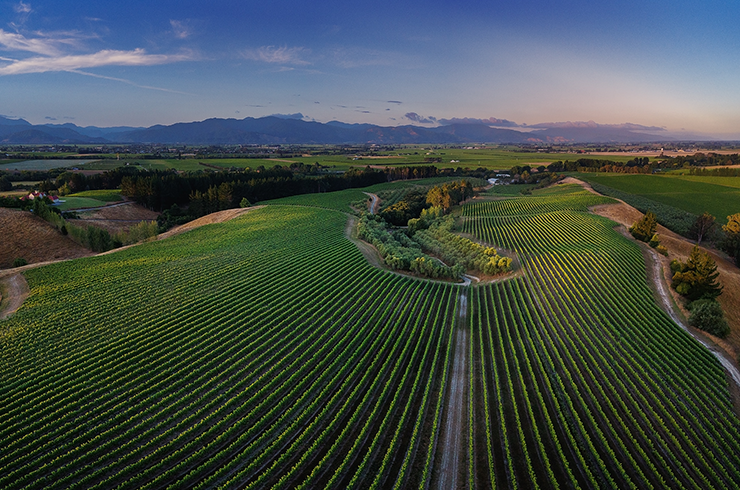A quick trip down memory lane provides some context for the modern wine cellar. Wine has been made for more than 5000 years, but the forerunners of the glass bottle we know today didn’t appear in England until 1636; bulbous hand-blown leviathans that could only be stored standing up, their stoppers many and various, wood wrapped in oiled cloth the most common. With the arrival of cylindrical bottles around 1740, bottles could be cellared on their side and cork stood out as the most efficient way of storing wine.
A quick personal note: a 1646 Tokay, purchased by Len Evans at Christie’s, London, is the oldest wine I have tasted. I have the pale blue striated glass bottle holding around 400ml in a rounded shape, with a cork inside its tiny neck. The wine itself was totally sound, but much of the sweetness had been lost over the centuries.
By 1800, the bottle and cork technology was well known and widely used, so we have a system that has been in use unchanged for more than 200 years. Its Achilles heel isn’t the bottle, but the cork. Space doesn’t allow me to explain all of the reasons here for the fallibility of cork, but I shall touch on one of the less discussed factors: each time the storage or transit temperature increases, so does the volume of the wine in the bottle, and when it cools, it decreases.
These changes aren’t obvious to the naked eye unless extreme, typically the hot phase (the sticky trickle down the outside of the neck and shoulder is a very visible sign). Each change creates a hydraulic shock to the cork’s position in the bottle. Over the years, the cork loses some of its elasticity, the consequences of temperature change past or present exacerbating the problem. So it is that I have thrown away well over 1000 bottles of older white wine (mainly Australian) and leaving more to go. I’ve been more circumspect with red wines, but there are more than 1000 bottles (again Australian) 30 to 50 years old that will never be drunk. The corks have failed in their most basic function of keeping the contents in the bottle.
A quick personal note: a 1646 Tokay, purchased by Len Evans at Christie’s, London, is the oldest wine I have tasted. I have the pale blue striated glass bottle holding around 400ml in a rounded shape, with a cork inside its tiny neck. The wine itself was totally sound, but much of the sweetness had been lost over the centuries.
By 1800, the bottle and cork technology was well known and widely used, so we have a system that has been in use unchanged for more than 200 years. Its Achilles heel isn’t the bottle, but the cork. Space doesn’t allow me to explain all of the reasons here for the fallibility of cork, but I shall touch on one of the less discussed factors: each time the storage or transit temperature increases, so does the volume of the wine in the bottle, and when it cools, it decreases.
These changes aren’t obvious to the naked eye unless extreme, typically the hot phase (the sticky trickle down the outside of the neck and shoulder is a very visible sign). Each change creates a hydraulic shock to the cork’s position in the bottle. Over the years, the cork loses some of its elasticity, the consequences of temperature change past or present exacerbating the problem. So it is that I have thrown away well over 1000 bottles of older white wine (mainly Australian) and leaving more to go. I’ve been more circumspect with red wines, but there are more than 1000 bottles (again Australian) 30 to 50 years old that will never be drunk. The corks have failed in their most basic function of keeping the contents in the bottle.

White wines, whether Australian or European, are the first casualties of cork, with premature oxidation randomly taking its toll.
As the years pass, the gap increases. The Penfolds Recorking Clinic has been a huge success in Australia, and now head winemaker Peter Gago has taken it overseas with similar success. Bottles of Grange and Special Bins are opened, the wine taste-tested and, if it is still sound, the bottle is topped up with good young wine, given a new cork and a certificate glued on the back specifying the date, and Langton’s (expert auctioneers, led by Andrew Caillard MW) certification.
White wines, whether Australian or European, are the first casualties of cork, with premature oxidation randomly taking its toll. French White Burgundy makers have battled the problem since the mid-1980s with limited success. Unwilling to entirely forsake these great wines, many Melbourne wine professionals and tasters have a five- to seven-year rule of thumb during which the wines must be drunk, the risk of oxidation inexorably increasing thereafter. By contrast, top-end Australian chardonnays under screwcap – the majority from Margaret River or the Yarra Valley, and dating back to the turn of the century – are developing slowly but surely, each and every bottle the same.
Hunter Valley semillon is arguably the greatest beneficiary of the screwcap, with Bruce Tyrrell on record saying this is semillon’s golden age. Vat 1 Semillon is the nectar of the gods, 2005 Vat 1 still incredibly youthful, with a gold-plated certainty of ambling through another 10 years. For the many wine drinkers outside Sydney who don’t ‘get’ Hunter Valley semillon, many of the best makers are offering semillon now or after its fifth birthday. If you still don’t get it, simply move on – like or dislike are purely personal choices, with no shame whatsoever attached.
Riesling moves synchronously with semillon, gaining complexity and richness over the first five to seven years of its life, then settling into decades of delicious maturity. Marsanne (a la Tahbilk) is in the same group. Germany, and in particular the Mosel Valley, is either switching to screwcaps or offering customers a choice. Austrian riesling and gruner veltliner are also prime candidates for cellaring with screwcaps.
The story changes radically with red wines, pinot noir being the halfway house. Pigmented tannins give red wines their colour and appear to me to be associated with antioxidant protection. Pinot noir has less, and different, tannins than those of the two other most important varieties – shiraz and cabernet sauvignon. The taste transparency of pinot noir reveals issues other than early oxidation, described as scalping.
Once again, and for all red wines, there is a witching hour when the cork gods descend from the skies. Take two bottles of the same wine, one sealed with a well-inserted, high-quality cork in a top quality bottle’s neck, the other with a screwcap. For the first five years, the comparison may result in a preference for the cork-sealed bottle. The reasons may be hard to articulate, almost a sixth sense, but real nonetheless.
Since 98.4 per cent of the white wines tasted for the 2017 Halliday Wine Companion were under screwcap, and 89.5 per cent of the red wines, it’s only with the latter that there is an element of choice with Australian wines. With European red wines, the situation is reversed, with little opportunity to buy wines with anything other than corks. Burgundian winemakers such as Benjamin Leroux are convinced the wines should use screwcap, but only bottles his larger-volume (cheaper) wines thus. Jean-Claude Boisset, the largest producer of Burgundy (of all types) understands the implications, briefly offering wines from Village to Grand Cru under screwcap, but retreated in the face of entrenched market resistance, Trump’s great country the most hostile to change.
The bottom line is simple: if you want to be sure, buy screwcapped wines for the cellar. Mount Mary uses cork for its red wines, and Farr uses Diam for both white and red wines. This puts the choice back into your court, but even I wouldn’t suggest you ignore these great producers.
White wines, whether Australian or European, are the first casualties of cork, with premature oxidation randomly taking its toll. French White Burgundy makers have battled the problem since the mid-1980s with limited success. Unwilling to entirely forsake these great wines, many Melbourne wine professionals and tasters have a five- to seven-year rule of thumb during which the wines must be drunk, the risk of oxidation inexorably increasing thereafter. By contrast, top-end Australian chardonnays under screwcap – the majority from Margaret River or the Yarra Valley, and dating back to the turn of the century – are developing slowly but surely, each and every bottle the same.
Hunter Valley semillon is arguably the greatest beneficiary of the screwcap, with Bruce Tyrrell on record saying this is semillon’s golden age. Vat 1 Semillon is the nectar of the gods, 2005 Vat 1 still incredibly youthful, with a gold-plated certainty of ambling through another 10 years. For the many wine drinkers outside Sydney who don’t ‘get’ Hunter Valley semillon, many of the best makers are offering semillon now or after its fifth birthday. If you still don’t get it, simply move on – like or dislike are purely personal choices, with no shame whatsoever attached.
Riesling moves synchronously with semillon, gaining complexity and richness over the first five to seven years of its life, then settling into decades of delicious maturity. Marsanne (a la Tahbilk) is in the same group. Germany, and in particular the Mosel Valley, is either switching to screwcaps or offering customers a choice. Austrian riesling and gruner veltliner are also prime candidates for cellaring with screwcaps.
The story changes radically with red wines, pinot noir being the halfway house. Pigmented tannins give red wines their colour and appear to me to be associated with antioxidant protection. Pinot noir has less, and different, tannins than those of the two other most important varieties – shiraz and cabernet sauvignon. The taste transparency of pinot noir reveals issues other than early oxidation, described as scalping.
Once again, and for all red wines, there is a witching hour when the cork gods descend from the skies. Take two bottles of the same wine, one sealed with a well-inserted, high-quality cork in a top quality bottle’s neck, the other with a screwcap. For the first five years, the comparison may result in a preference for the cork-sealed bottle. The reasons may be hard to articulate, almost a sixth sense, but real nonetheless.
Since 98.4 per cent of the white wines tasted for the 2017 Halliday Wine Companion were under screwcap, and 89.5 per cent of the red wines, it’s only with the latter that there is an element of choice with Australian wines. With European red wines, the situation is reversed, with little opportunity to buy wines with anything other than corks. Burgundian winemakers such as Benjamin Leroux are convinced the wines should use screwcap, but only bottles his larger-volume (cheaper) wines thus. Jean-Claude Boisset, the largest producer of Burgundy (of all types) understands the implications, briefly offering wines from Village to Grand Cru under screwcap, but retreated in the face of entrenched market resistance, Trump’s great country the most hostile to change.
The bottom line is simple: if you want to be sure, buy screwcapped wines for the cellar. Mount Mary uses cork for its red wines, and Farr uses Diam for both white and red wines. This puts the choice back into your court, but even I wouldn’t suggest you ignore these great producers.
Latest Articles
-
Wine Lists
The 50 most popular wines of 2025
just now -
Wine Lists
A snapshot of top New Zealand wines (all rated 91 points and above)
1 day ago -
Behind the label
Taste Aotearoa: Get to know these five New Zealand wineries
1 day ago -
Wine Lists
Just in: 14 newly reviewed wines to try this December
2 days ago



